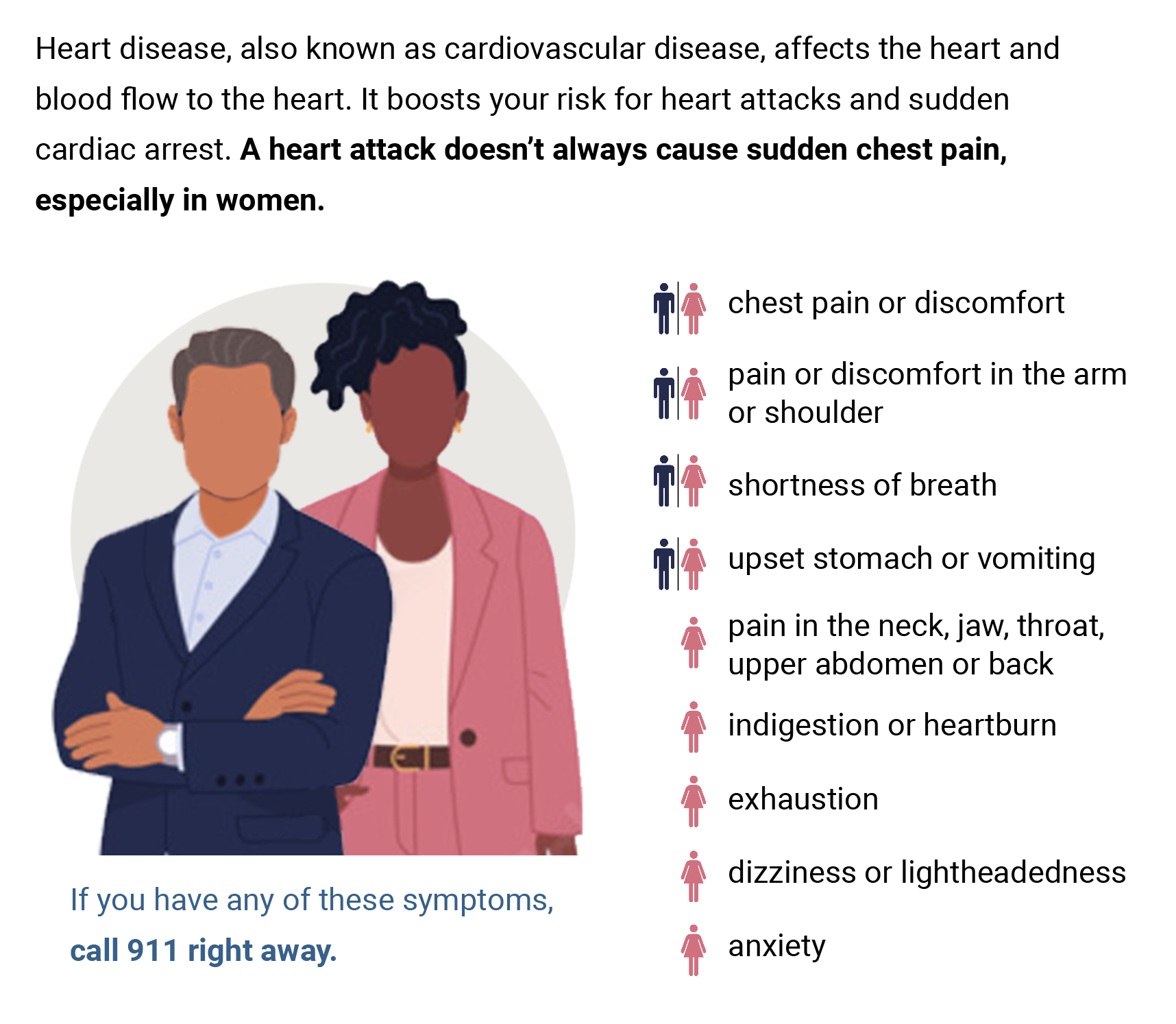

This page may have documents that can’t be read by screen reader software. For help with these documents, please call the number on the back of your member ID card.

You may feel a heart attack as:
Don’t let the fear of being wrong stop you from making a lifesaving phone call. If it’s not a heart attack, those same signs often warn of heart disease. Along with symptoms it shares with heart attacks, heart disease may feel like:
Several health conditions, lifestyle choices and your family history can increase your risk for heart disease, like:
You can’t control your family history, but the good news is that many heart attacks are preventable with the right lifestyle changes. Diet and exercise are a great place to start. You have access to numerous resources with your TRS-ActiveCare plan.
About Heart Disease, Centers for Disease Control and Prevention, 2022. Women and Heart Disease, Centers for Disease Control and Prevention, 2023.
A poor diet and lack of exercise can cause plaque to form in arteries. Plaque buildup can begin as early as adolescence. This paves the way for a possible heart attack.
There are lifestyle choices and changes you can make to lower your risk. When you control your risk factors, you help protect your heart. It’s easy to get started.
Healthy eating doesn’t need to be hard. You don’t have to spend a lot of time tracking your daily calories or buy special diet products. Find a healthy approach to what you eat, focusing on simple, easy to find, wholesome foods.
Talk to your doctor before you start a new eating plan to find out what changes are best for you.
Heart health isn’t only about what you eat! Your heart is a muscle – it needs to “work-out.” Adding exercise to your life doesn’t mean training for a marathon. The most important types of exercise for your heart are aerobic and resistance training.
Aerobic exercise involves repeated movement that increases your heart rate and breathing rate. It helps your heart pump more efficiently, improves your circulation and blood pressure and reduces your risk of heart disease, stroke and type 2 diabetes. Aim to get at least 30 minutes of moderate aerobic activity a day, five days a week, like:
Resistance training, or strength work, helps increase your muscle mass and reduce your body fat and other risks for heart disease. It works best in combination with aerobic exercise. Add muscle strengthening activities into your routine twice a week with:
You should talk to your doctor before starting a new fitness routine. Remember that a little means a lot when it comes to improving your fitness level. Start at a level your comfortable with and increase intensity and time as you get stronger.
Your TRS-ActiveCare plan can help you make healthy lifestyle changes like eating better and exercising. Join The Fitness Program to get access to a nationwide network of fitness locations at a discount, work on your nutrition with a Wellness Coach or sign up for a digital course through Well OnTarget®.
What is the MIND diet?, Food Insight, International Food Information Council, 2019; Debating Diets: What is the MIND diet?, Baylor College of Medicine, 2020; 3 Kinds of Exercise That Boost Heart Health, Johns Hopkins Medicine.
Explore previous tips and tricks.
Breast Cancer
Knowing how your breasts look and feel can help you notice symptoms that may be of concern. Make a point to examine them once a month.
1. Look at your breasts in a mirror with your hands on your hips. Look for:
2. Look for the same changes with your arms raised.
3. Feel for lumps lying down and standing up.
Click here for more information on breast self-exams, including instructional pictures.
Skin Cancer
The best time to do this exam is after a shower or bath. Check your skin in a room with plenty of light. Use a full-length mirror and a hand-held mirror. It's best to begin by learning where your birthmarks, moles and other marks are, and their usual look and feel.
Check for:
Check yourself from head to toe.
1. Look at your face, neck, ears and scalp. You may want to use a comb or a blow dryer to move your hair so that you can see better.
2. Look at the front and back of your body in the mirror. Then, raise your arms and look at your left and right sides.
3. Bend your elbows. Look carefully at your fingernails, palms, forearms (including the undersides), and upper arms. Examine the back, front and sides of your legs. Also look around your genital area and between your buttocks.
4. Sit and closely examine your feet, including toenails, soles and the spaces between your toes.
By checking your skin regularly, you’ll learn what’s normal for you. If you find anything unusual, see your PCP.
Testicular Cancer
Regular testicular self-examinations can help identify growths early when the chance for successful treatment of testicular cancer is highest.
A testicular self-exam is best performed after a warm shower because heat relaxes the scrotum, making it easier to spot anything abnormal. Follow these steps every month:
1. Stand in front of a mirror. Check for any swelling on the scrotum skin.
2. Examine each testicle with both hands. Place the index and middle fingers under the testicle with the thumbs placed on top. Roll the testicle gently between the thumbs and fingers. Don't be alarmed if one testicle seems slightly larger than the other. That's normal.
3. Find the epididymis, the soft, tubelike structure behind the testicle that collects and carries sperm. If you are familiar with this structure, you won't mistake it for a suspicious lump. Cancerous lumps usually are found on the sides of the testicle but can also show up on the front.
If you find a lump, see your PCP. Only a doctor can make a positive diagnosis.
Source: Self Screening, Illinois Department of Public Health.